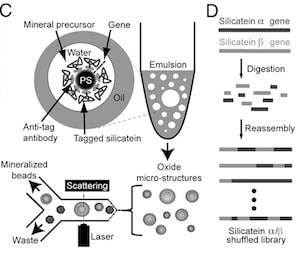
In considering biomolecule-based paths toward advanced nanotechnology, one wonders how limited biomolecules might prove to be in synthesizing materials that are not based upon biomolecules. This could be particularly problematic in the case of materials that would kill the bacteria that are used in standard genetic engineering technologies. Now University of California, Santa Barbara, scientists have developed synthetic cells that can be used to evolve enzymes that make novel structures not seen in nature of silicon dioxide and titanium dioxide. A hat tip to KurzweilAI.net for pointing to this ars technica report “Artificial cells evolve proteins to structure semiconductors“:
… The scientists synthesized the proteins coded for by these new genes and studied the minerals produced by each one. The standard protein, silicatein α, makes clumps of silica particles. Both new proteins, however, produced dispersed nanoparticles containing the metal oxides. And the new silica-forming protein, named silicatein X1, could even make folded sheets of silica-protein fibers.
Directed evolution is not limited to these silica-forming proteins, as other organisms have proteins to make interesting materials too. Some marine sponges produce fiberglass that could be used as optical wave guides. And some bacteria build magnetic nanoparticles.
In this work, the scientists demonstrated that directed evolution of a mineral-producing protein could create materials with never-before seen structures. The next challenge is to learn how to change the selection pressures to evolve a specific property, such as semiconductor performance. “This approach will begin to allow the same DNA-based evolutionary processes that have created seashells and skeletons to be harnessed to advance human technologies,” they write.
Another hat tip to KurzweilAI.net for additional details in this press release from UCSB “UCSB Scientists Synthesize First Genetically Evolved Semiconductor Material“:
… Using silicateins, proteins responsible for the formation of silica skeletons in marine sponges, the researchers were able to generate new mineral architectures by directing the evolution of these enzymes. Silicateins, which are genetically encoded, serve as templates for the silica skeletons and control their mineralization, thus participating in similar types of processes by which animal and human bones are formed. Silica, also known as silicon dioxide, is the primary material in most commercially manufactured semiconductors.
In this study, polystyrene microbeads coated with specific silicateins were put through a mineralization reaction by incubating the beads in a water-in-oil emulsion that contained chemical precursors for mineralization: metals of either silicon or titanium dissolved in the oil or water phase of the emulsion. As the silicateins reacted with the dissolved metals, they precipitated them, integrating the metals into the resulting structure and forming nanoparticles of silicon dioxide or titanium dioxide.
With the creation of a silicatein gene pool, through what Bawazer only somewhat euphemistically calls “molecular sex” –– the combination and recombination of various silicatein genetic materials –– the scientists were able to create a multitude of silicateins, and then select for the ones with desired properties.
“This genetic population was exposed to two environmental pressures that shaped the selected minerals: The silicateins needed to make (that is, mineralize) materials directly on the surface of the beads, and then the mineral structures needed to be amenable to physical disruption to expose the encoding genes,” said Bawazer. The beads that exhibited mineralization were sorted from the ones that didn’t, and then fractured to release the genetic information they contained, which could either be studied, or evolved further.
The process yielded forms of silicatein not available in nature, that behaved differently in the formation of mineral structures. For example, some silicateins self-assembled into sheets and made dispersed mineral nanoparticles, as opposed to more typical agglomerated particles formed by natural silicateins. In some cases, crystalline materials were also formed, demonstrating a crystal-forming ability that was acquired through directed evolution, said Bawazer. …
The research was published in Proc. Nat. Acad Sci. USA [abstract, open access full text]. It looks like these researchers have found a way to discover new materials through in vitro enzyme selection. Perhaps the next challenge is to assemble such novel materials into complex devices.
—James Lewis, PhD

